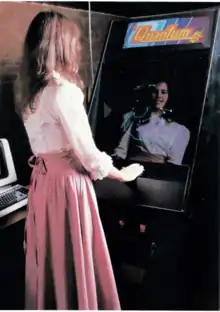Elizabeth Betty Ryan
Elizabeth (Betty) Ryan (formerly Tylko) is an American game developer and programmer. She worked for General Computer Corporation (GCC) in the 1980s and was the 9th employee and first woman video game programmer at GCC. She programmed the 1982 Atari, Inc. arcade game Quantum as well as working on games for the Atari 2600, Atari 5200, and Atari 7800.
Elizabeth (Betty) Ryan | |
|---|---|
 | |
| Other names | Betty Ryan Tylko |
| Occupation | Computer programmer Video game developer |
| Known for | Quantum |
Education
Ryan received a Bachelor of Arts in Engineering and Applied Sciences from Harvard University and she was a member of the Class of 1980.[1]
Career
Ryan wrote the software for the Atari arcade game Quantum,[2] which was developed by the General Computer Corporation (GCC) for Atari. She was the 9th employee and first woman game developer at the company. Her sister Carol Ryan Thomas was also hired later on as a tester and debugger of the video games.[3] After Quantum, she worked on other games for the Atari 2600, 5200, and 7800, including Pole Position,[4] Dig Dug, Atari Lab, and GCC's unreleased version of Millipede for the Atari 7800.[5]
Ryan has spoken about her work in game development for the American Classic Arcade Museum.[6]
Since 2003, she has been working in web development with her son John Tylko.[7]
Games
- Quantum (arcade, 1982)
- Pole Position (Atari 2600, 1982) port from arcade
- Dig Dug (1983) port from arcade
- AtariLab (1983)
References
- "Pioneers of the 'Women in Computer Science' movement". Tumblr home of the Harvard School of Engineering and Applied Sciences (SEAS). Retrieved 28 September 2020.
- "Quantum, Arcade Video Game by Atari, Inc. (1982)". Arcade History database. Retrieved 28 September 2020.
- "Carol Ryan Thomas". atariwomen. 14 May 2019.
- "Pole Position". Atari Mani. Retrieved 28 September 2020.
- "Betty Ryan Tylko – atariwomen". Atari Women. 2019-05-13. Retrieved 2020-10-27.
- "ACAM Education Program". www.classicarcademuseum.org. Retrieved 2020-10-27.
- "Tylko Design :: Website Design and Development". www.tylkodesign.com. Retrieved 2020-10-27.
- "AtariProtos: Milipede". www.atariprotos.com. Retrieved 2020-11-13.
External links
- Betty Ryan Tylko at Atari Women
